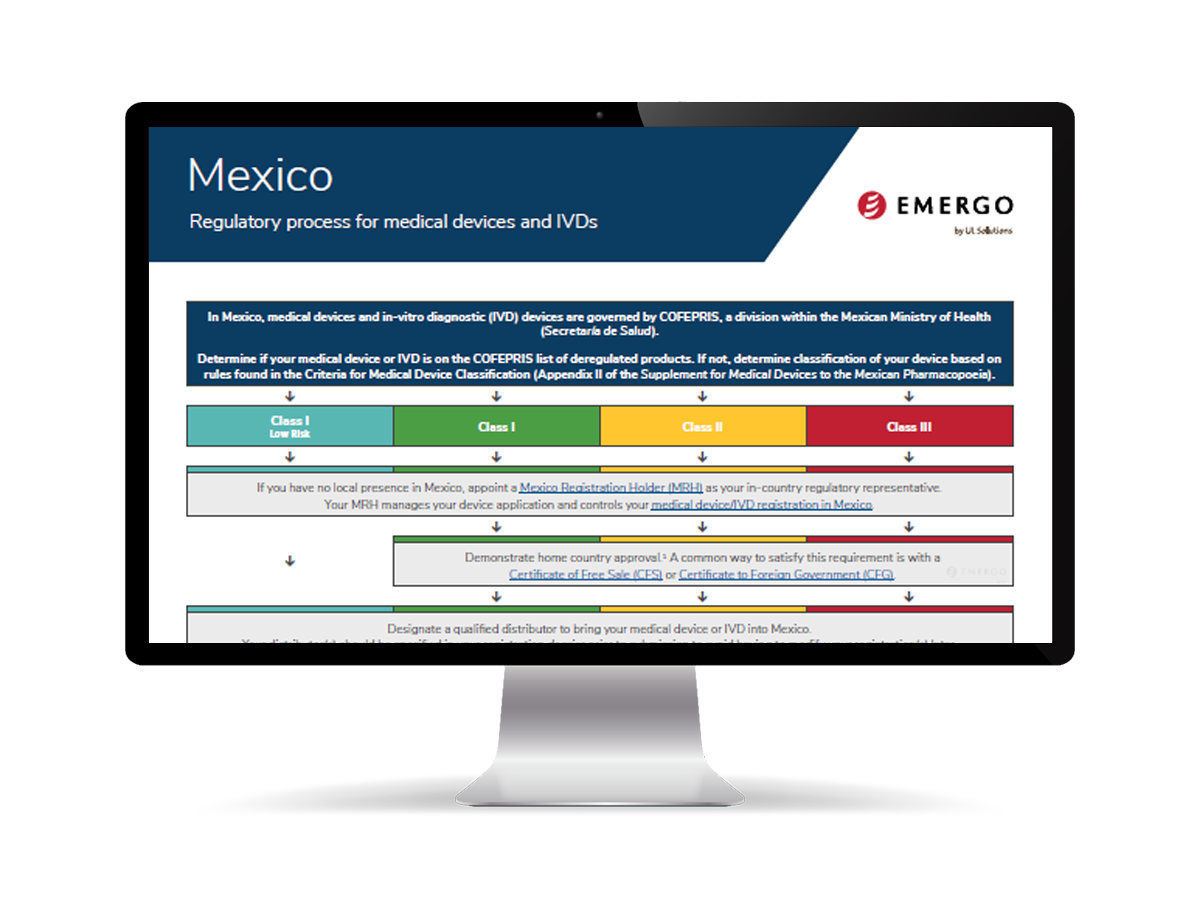ANSWERED ON THIS PAGE:
- What is the classification scheme for medical devices in Mexico?
- How does device grouping affect our registration process?
- What are the different medical device registration routes in Mexico?
Mexico is the second-largest medical device market in Latin America after Brazil and can be a profitable target for medical device and IVD manufacturers. However, registering a device or IVD in Mexico can be a lengthy challenging process. COFEPRIS, the division of the Mexican Ministry of Health responsible for medical device and IVD oversight, provides limited information about the registration process online. With an office of experienced consultants in Mexico City, Emergo by UL can help you access this growing market.
Emergo by UL provides assistance with COFEPRIS medical device classification and grouping
The first step towards registration in Mexico is classifying your medical device. COFEPRIS classification rules are adapted from European rules, with some differences that are unique to Mexico.
Medical devices are classified based on increasing risk using a three-tier system: Class I, Class II, and Class III. COFEPRIS also provides a list of products considered Class I Low Risk, which are still regulated but have faster review and approval times.
Family grouping can impact the number of required registrations and may be advantageous if you want to register different models or variations of the same device. Emergo offers initial classification and grouping determination that draws on guidance reference, device equivalence, and our experience grouping hundreds of COFEPRIS submissions.
The medical device approval process in Mexico
You have two options when seeking approval from COFEPRIS. Emergo by UL can recommend the most efficient option for your device and tell you the pros and cons of each process. Our Mexican Regulatory Approval Process for Medical and IVD Devices process chart helps explains the COFEPRIS approval process.
Equivalency Review Process - If your device has been approved in the US, Canada, or Japan, you may qualify for an equivalency review. Equivalency reviews require the submission of a Summary Dossier with less detailed technical information. For Health Canada- and FDA-approved devices, the process is faster than the standard review, and it requires less paperwork. This route is equally efficient for manufacturers with approval in Japan who are able to provide an Exportation Certificate from the MHLW.
Standard Review Process – Emergo can assist you in preparing a detailed Registration Dossier that includes full product technical information and applicable testing results. Applications going through the standard review process are also eligible for Third Party Review, at a cost. Standard route application timelines are significantly longer than equivalency timelines, and Third Party Review does not have a noticeable impact on the review.
Class I Low Risk devices require you to submit an application with basic company and device information to COFEPRIS, and will regularly be subject to fast review and approval timelines with COFEPRIS.
Note that if you have no local presence in Mexico, you will need to appoint a Mexico Registration Holder to serve as your in-country representative.
Successfully register medical devices with COFEPRIS in Mexico
Emergo by UL has submitted hundreds of devices for approval in Mexico, and our staff includes bilingual regulatory professionals with thorough experience, so we understand what is needed to get your devices approved in the most efficient manner possible. We will:
- Determine classification and registration route for your medical device or IVD.
- Help you determine a grouping strategy for your registration, if applicable.
- Identify the required documentation for your registration route.
- Act as your independent Mexico Registration Holder.
- Prepare and submit registration application documents to COFEPRIS.
- Field questions from COFEPRIS during the submission process.
Mexico is a growing Latin American market that relies almost entirely on imports. This makes it a lucrative market for device companies. Let us help you obtain approval from COFEPRIS so you can start selling in Mexico. Please contact us for more information about medical device registration and approval consulting.
FAQs about medical device registration, regulation and approval in Mexico
How long does it take to register a medical device in Mexico?
Approval timeframes vary by device class and whether you choose Third Party Review. Please see our Mexican Regulatory Approval Process for Medical and IVD Devices process chart for a detailed look at timelines and costs.
Is ISO 13485 required to register in Mexico?
Technically no, but companies must provide proof of an audited quality system to register in Mexico. Most manufacturers provide their ISO 13485 certificate. However, a quality system certificate issued by a government agency may be accepted.
What are Third Party Reviewers (TPR)?
Third Party Reviewers are independent, accredited commercial entities authorized by COFEPRIS to "pre-approve" medical device applications. They are local Mexican companies and are not associated with any globally recognized registrars/Notified Bodies. They will review the dossier in detail, often requesting more information from the manufacturer before issuing their pre-approval letter. COFEPRIS will then complete a final review and issue the registration certificate. There is an additional cost to use a TPR, and nowadays there is no discernible difference in the review timeline.
Can Emergo recommend a Third Party Reviewer to me?
If selected as your registration holder, Emergo by UL will contract with the TPR on your behalf. As a part of this process, we’ll provide feedback on the reviewers we have worked with as well as their pricing so that you can make an informed decision. We will also help communicate with them throughout the process.
How important is family grouping to the registration process?
Family grouping impacts the number of registrations you must complete. For example, devices that might be grouped into one registration in Europe or the US commonly require multiple registrations in Mexico. This adds time and costs to your registration project.
Family grouping depends on various factors, such as the intended use, raw materials (generally for implantable devices), or significant technological differences between products in the same group. Emergo has the experience to help you define a grouping strategy to make the most of your time and budget.
Request information from our specialists
Thanks for your interest in our products and services. Let's collect some information so we can connect you with the right person.









